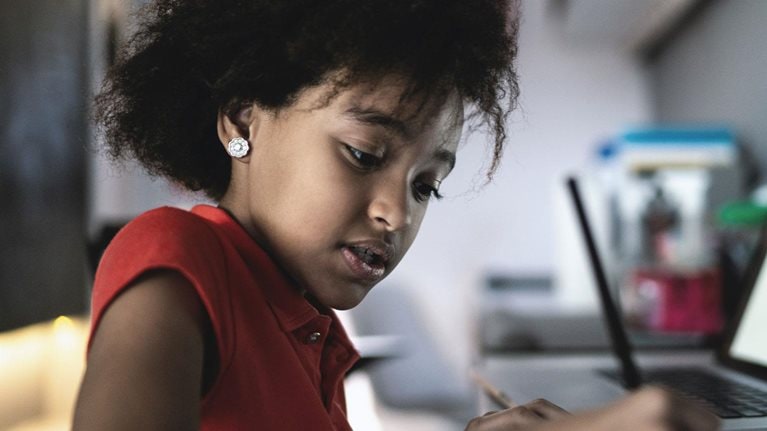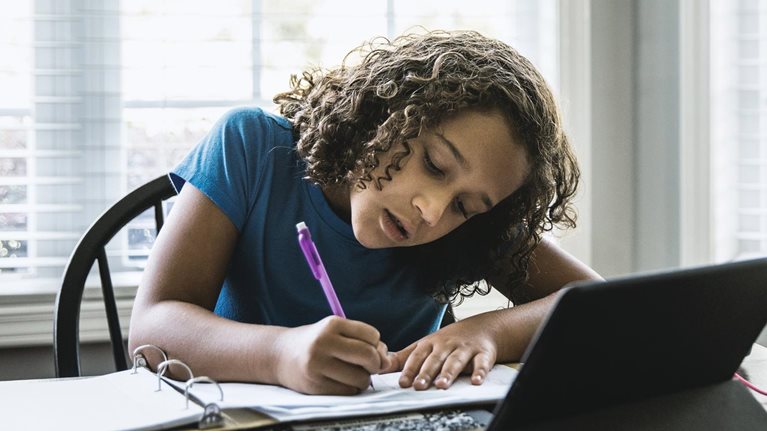Across the nation this fall, school bells once more summoned students back to classrooms that, in some districts, had stood empty for the previous year and a half. According to Burbio, a data service that aggregates school and community calendars, 100 percent of public-school students are attending schools in districts that offer fully in-person instruction this fall compared with 73 percent last spring. Meanwhile, 91 percent of students taking interim assessments through educational-technology company Curriculum Associates this fall did so in school buildings, up from just 64 percent in the spring and 34 percent the previous fall. This research therefore provides the first opportunity to truly understand the impact of the pandemic on learning for all students (see sidebar, “About the research”).1
Our analysis finds that students remain behind in both math and reading. What’s more, gains made since the spring are uneven. While some students are making up lost ground, others are stagnating. For example, students in majority-Black schools remain five months behind their historical levels in both mathematics and reading, while students in majority-White schools are now just two months behind their historical levels, widening prepandemic achievement gaps.2 This means that, in math, students in majority-Black schools are now 12 months behind their peers in majority-White schools, having started the pandemic nine months behind. Similarly, concerns around student mental health have lessened somewhat since the spring, but they remain higher than before the pandemic.
Furthermore, we aren’t even out of the woods yet. Disruptions to learning are not over, and student attendance rates lag significantly behind prepandemic levels. While actual closures of whole schools or districts have affected just 9 percent of students, quarantines and other disruptions have affected 17 percent of in-person students. On top of school closures, absenteeism rates have risen, with 2.7 times as many students on a path to be chronically absent from school this year compared with before the pandemic. While absenteeism rates for high-income students are leveling off, rates for low-income students have continued to worsen since the spring, despite the return to in-person school. If historical correlations between chronic absenteeism and high school graduation hold, this could translate into an additional 1.7 million to 3.3 million eighth–12th graders dropping out of school because of the pandemic.3
Varying access to support programs could be another reason why some students seem to be bouncing back more quickly than others. More than $200 billion has been allocated by the federal government to K-12 schooling, but just a small portion of that has reached students thus far, and parents report uneven access to benefits. High-income parents are 21 percentage points more likely to report their child has participated in a program to support either academic or mental-health recovery, including tutoring, summer school, after-school programs, and counseling and mentoring.4 If current trends persist, students from high-income families could recover unfinished learning by the end of this school year. Historically disadvantaged students, meanwhile, could remain up to a grade level behind their peers.5
As districts plan for further recovery programs, an understanding of which students most need support can help inform decisions and begin to close both preexisting and new opportunity and achievement gaps.
How students are doing today
A few months into this school year, students appear to be performing better academically and feeling better than they were last spring. However, indicators of both academic performance and broader well-being are still well below prepandemic levels.
The amount of unfinished learning varies significantly across schools
Our sample of the Curriculum Associates i-Ready assessment data, which covers nearly three million students across 50 states,6 suggests students are four months behind in mathematics and three months behind in reading compared with students in matched schools in previous years. This level of unfinished learning is about a month less (that is, better) compared with the spring, suggesting students may be making up some of the academic ground they lost during the pandemic.
However, a deeper look at the data reveals the amount of unfinished learning is far from equitable. Students in majority-Black schools are five months behind where they would otherwise have been, both in math and reading. Students in majority-White schools are now just two months behind historical levels (Exhibit 1).

Inequalities were already baked into the historical levels: even before the pandemic, students in majority-Black schools were nine months behind students in majority-White schools in mathematics in the Curriculum Associates data set. Students in majority-Black schools are now a full 12 months behind those in majority-White schools, widening the preexisting achievement gap between Black and White students by about a third (Exhibit 2).
Within classrooms, teachers face a wider range of student needs than ever
The differences identified in our analysis are likely even greater at the student level. In the United States, the variation among students within a school is typically three times greater than the variation among schools.7 This fall, each classroom likely included students with a broad range of experiences during the past year and a half. Where students stand compared to grade-level expectations reveals this disparity.8 In math, for example, the share of students at grade level or above has decreased by six percentage points since the pandemic, while the share of students who are two or more grade levels below has increased by nine percentage points.9 This pattern means that in a math classroom of 30 fourth-grade students, for example, three additional students are now two or more grade levels below (Exhibit 3). This makes an already difficult job tougher, as teachers need to tailor their instruction to an even broader set of student needs.

This is most concerning for early-elementary students in reading and mid- to late-elementary students in math. Students who do not learn to read proficiently by third grade struggle to “read to learn” thereafter and are four times less likely to graduate high school.10 Similarly, students who do not master middle-grade math concepts such as fractions and whole-number division will likely struggle in more conceptual high school mathematics and are less likely to graduate high school on time.11
High school students have also fallen behind
We drew on state assessments to understand the pandemic’s impact on older students. A subset of states administered assessments in spring 2021, but many had low participation rates, making the results difficult to compare. Where data are available, the story is sobering. For the 13 states12 with participation rates higher than 90 percent, the proportion of students meeting proficiency standards dropped by an average of five percentage points in math and three percentage points in English language arts. These declines are similar in magnitude to the reduction in students achieving grade-level proficiency in the Curriculum Associates data set,13 suggesting the pandemic may be having an equal impact on high school learning. Furthermore, these results likely underestimate unfinished learning in high school, as the states and students experiencing the longest disruption are not reflected in the assessments.
The pandemic’s impact goes beyond academics
Parents remain concerned about their children’s academic performance, school attendance, and mental health. This level of concern has dropped since the spring but remains higher than before the pandemic. In our survey, for example, 21 percent of parents reported being very or extremely concerned about their child’s mental health before the pandemic. This share spiked to 35 percent in June 2021 and dropped back to 28 percent this November. Parents of Black and Hispanic students have higher levels of concern across all areas (Exhibit 4).

Across the board, the picture a few months into the fall semester looks marginally better, on average, than it did in the spring, but the top-line numbers hide a lot of variability. Upon delving deeper, many students—especially those from historically disadvantaged backgrounds—still need help.
Ongoing disruptions to learning
Before states and districts can fully help students recover from the pandemic, disruptions to learning must end. Burbio reports 1,282 school closures since the start of the 2021–22 school year.14 That means 9 percent of public-school students have been affected by a school closure, with the average closure lasting two days.15 However, in ten states, more than 15 percent of students have endured closures (Exhibit 5).

Our parent survey paints an even less rosy picture (Exhibit 6). Of all students who chose to attend fully in-person learning this fall,16 just 83 percent attended ten full days during the two weeks the survey was in the field.17 Parents of Black and Hispanic students were slightly more likely to report disruptions to their children’s in-person learning experience.

It is not just the duration of disruption that matters; the alternative to in-person learning is also critical. In the case of school closures, Burbio data suggest students received some form of virtual instruction 54 percent of the time when disruptions occurred. In some states, that number was much lower: in Arkansas, Iowa, Maryland, Missouri, Tennessee, and Texas, students received instruction during less than 10 percent of school closures.
Our parent survey also indicates a wide variety of options when in-person school is disrupted. Of all disrupted days (excluding holidays), alternatives provided by districts included synchronous virtual (54 percent), asynchronous virtual (30 percent), and no instruction at all (15 percent).18 Parent satisfaction with the quality of learning options provided also varied significantly. While 75 percent of parents had high or very high confidence in the quality of fully in-person education, that total dropped to 64 percent for parents whose children experienced disruptions to learning.
Reducing the number of disruptions requires an understanding of what is causing them. The Burbio data suggest that confirmed or suspected COVID-19 cases in staff, students, or the local community account for only 12 percent of closure days.19 Pandemic-related stressors are causing most of the disruptions: 50 percent of closure days are the result of primarily single-day breaks that school districts have taken to support student and staff mental health. Staff shortages also make up a significant portion (13 percent) of closure days. For individual students, our parent survey suggests campus closures account for only 45 percent of total missed days, with quarantines making up 12 percent and sickness an additional 6 percent.20 Parents of Black and Hispanic students were most likely to report that campus closures were the cause of their students’ interruptions to in-person learning.
Even if school is open, students don’t always attend. Accounts of rising absenteeism have emerged in recent months. Nearly half of Cleveland’s students are on track to be chronically absent this school year.21 An analysis of 30 districts in California, representing more than 330,000 students, shows rates of chronic absenteeism have more than doubled since the pandemic started.22
Our parent survey suggests these news stories are not isolated anecdotes. According to respondents, just over half of students attended school every day this fall. Many students are missing multiple days of school. Before the pandemic, about 8 percent of parents reported that their children were chronically absent from school (missing 15 days or more of school during the year23). In the spring, chronic absenteeism more than doubled, to 18 percent. This fall, those numbers increased again, with 22 percent of parents now reporting their child is on track to be chronically absent this school year.24 Put another way, parent reports of chronic absenteeism have increased by a factor of 2.7 since before the pandemic. Low-income students, who often lack access to resources to make up for lost instruction in the classroom and who are more likely to experience ongoing attendance barriers,25 are 1.6 times more likely to be missing multiple days of school than their high-income peers (Exhibit 7).

Previous research has revealed that parents tend to underestimate their children’s absent days by a factor of two26—suggesting nearly one-third of students across the country may be on track to be chronically absent this school year. Based on historical links between chronic absenteeism and dropout rates, as many as 1.7 million to 3.3 million eighth–12th graders could drop out of school due to the pandemic without coordinated efforts to reengage them in learning.27
Efforts to support student recovery
Many school systems around the country are balancing their efforts to continue limiting disruptions while supporting student recovery. The federal government has committed more than $200 billion to K-12 education during the next three years through the Elementary and Secondary School Emergency Relief (ESSER) and Governor’s Emergency Education Relief (GEER) funds, with most of the support going directly to school districts.28 It is still too soon to determine whether this funding is being spent on programs that will help students who need it most, but available data provide an overview of existing district commitments and initial parent experience.
Burbio has collected information from 1,420 districts in 44 states on their plans for ESSER III funding (the largest and most recent tranche). Across those districts, 67 percent of funds have been committed thus far.29 Of that amount, 28 percent is focused on academic recovery, with a further 6 percent on mental-health recovery. Within academic recovery, summer school and after-school programs account for 34 percent of funding, while tutoring makes up just 7 percent.30 An analysis of committed funds may underestimate the portion of districts planning different acceleration efforts. The Center on Reinventing Public Education (CRPE) reports that 71 percent of the top 100 districts are planning to extend learning, while 62 percent intend to roll out some form of tutoring, and 45 percent want to expand small-group instruction.31
Meanwhile, just over half of parents report their students have participated in some form of academic or mental-health recovery program. The largest number of students attended tutoring, homework help, or test-preparation services, followed by academic after-school programs and mental-health and counseling support. Despite the large amount of funds directed to summer school, a smaller portion of students participated in these programs. High-income students are nearly twice as likely to have participated in several of these recovery programs (Exhibit 8).

Students most commonly access these programs through free-of-charge offerings at their schools, with a mix of community organizations and programs paid for by parents making up the balance. Schools provided more than 60 percent of in-person academic summer school and more than 50 percent of in-person tutoring, after-school, and mentoring programs free of charge. Parents were more likely to pay for mental-health or counseling services, with only about 30 percent receiving these offerings from schools.
Our survey suggests unmet demand for some services (Exhibit 9). Across income and ethnicity groups, parents are most interested in in-person tutoring and in-person after-school programs; summer school was at the bottom of the list. In every category, in-person programs are more sought after than virtual ones. Low-income parents are much more likely than high-income parents to say they are not interested in any programs: 33 percent versus 20 percent.

A comparison of the two data sets highlights a possible mismatch between what parents say they want for their children and where districts are currently investing funds. While around 21 percent of ESSER III funds committed for academic recovery are directed toward summer school,32 only 17 percent of parents are interested in this option. Meanwhile, 7 percent of funds committed for academic recovery are directed to tutoring, yet 29 percent of parents are interested in this option.
In addition, the students who need services most may not be receiving them. High-income students have less unfinished learning, on average, than low-income students. Yet high-income parents are both more concerned about their children’s academic performance and more likely to have signed up their children for programs to help them recover. They are also more satisfied with academic and mental-health recovery programs provided by their children’s school. A more targeted approach may be required to ensure that low-income students and other vulnerable populations are able to access high-quality support and recovery programs.
After an incredibly challenging period, initial research suggests some students are beginning to settle back into their prepandemic school routines. However, prepandemic education was failing many students, and these inequalities have been exacerbated by the pandemic, causing some segments—primarily low-income students and students of color—to fall even further behind their peers. Moreover, disruptions to learning continue, and programs to support students are not always reaching the ones who need it most. If this trend continues, the pandemic could leave students with increasingly unequal access to education and opportunity.
Decades of education research have reinforced the relationship between poverty and depressed learning outcomes, and the income achievement gap has grown over the past three decades as income inequality has risen.33 An inclusive economic recovery will be important to avoid further exacerbating widening gaps in learning outcomes. School systems are increasingly swimming upstream against these strong educational and economic currents. To not only prevent widening gaps in opportunity and achievement but also close them, systems can invest now to ensure all students have the chance to recover from the pandemic’s many setbacks and reach their full potential.


